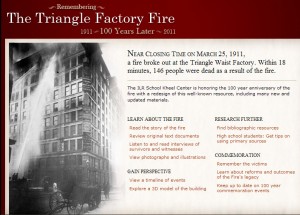Triangle Shirtwaist Factory Fire New York City 1911
By Christopher J. Naum, SFPE on Jan 22, 2011 with Comments 0

http://www.ilr.cornell.edu/trianglefire/
The Triangle Waist Company was in many ways a typical sweated factory in the heart of Manhattan, at 23-29 Washington Place, at the northern corner of Washington Square East. Low wages, excessively long hours, and unsanitary and dangerous working conditions were the hallmarks of sweatshops.
Even though many workers toiled under one roof in the Asch building, owned by Max Blanck and Isaac Harris, the owners subcontracted much work to individuals who hired the hands and pocketed a portion of the profits. Subcontractors could pay the workers whatever rates they wanted, often extremely low. The owners supposedly never knew the rates paid to the workers, nor did they know exactly how many workers were employed at their factory at any given point. Such a system led to exploitation.
Even today, sweatshops have not disappeared in the United States. They keep attracting workers in desperate need of employment and illegal immigrants, who may be anxious to avoid involvement with governmental agencies. Recent studies conducted by the U.S. Department of Labor found that 67% of Los Angeles garment factories and 63% of New York garment factories violate minimum wage and overtime laws. Ninety-eight percent of Los Angeles garment factories have workplace health and safety problems serious enough to lead to severe injuries or death.
The International Ladies’ Garment Workers Union organized workers in the women’s clothing trade. Many of the garment workers before 1911 were unorganized, partly because they were young immigrant women intimidated by the alien surroundings. Others were more daring, though. All were ripe for action against the poor working conditions. In 1909, an incident at the Triangle Factory sparked a spontaneous walkout of its 400 employees. The Women’s Trade Union League, a progressive association of middle class white women, helped the young women workers picket and fence off thugs and police provocation. At a historic meeting at Cooper Union, thousands of garment workers from all over the city followed young Clara Lemlich’s call for a general strike.
With the cloakmakers’ strike of 1910, a historic agreement was reached, that established a grievance system in the garment industry. Unfortunately for the workers, though, many shops were still in the hands of unscrupulous owners, who disregarded basic workers’ rights and imposed unsafe working conditions on their employees.
ear closing time on Saturday afternoon, March 25, 1911, a fire broke out on the top floors of the Asch Building in the Triangle Waist Company. Within minutes, the quiet spring afternoon erupted into madness, a terrifying moment in time, disrupting forever the lives of young workers. By the time the fire was over, 146 of the 500 employees had died. The survivors were left to live and relive those agonizing moments. The victims and their families, the people passing by who witnessed the desperate leaps from ninth floor windows, and the City of New York would never be the same.
Survivors recounted the horrors they had to endure, and passers-by and reporters also told stories of pain and terror they had witnessed. The images of death were seared deeply in their mind’s eye.
Many of the Triangle factory workers were women, some as young as 15 years old. They were, for the most part, recent Italian and European Jewish immigrants who had come to the United States with their families to seek a better life. Instead, they faced lives of grinding poverty and horrifying working conditions. As recent immigrants struggling with a new language and culture, the working poor were ready victims for the factory owners. For these workers, speaking out could end with the loss of desperately needed jobs, a prospect that forced them to endure personal indignities and severe exploitation. Some turned to labor unions to speak for them; many more struggled alone. The Triangle Factory was a non-union shop, although some of its workers had joined the International Ladies’ Garment Workers’ Union.
New York City, with its tenements and loft factories, had witnessed a growing concern for issues of health and safety in the early years of the 20th century. Groups such as the International Ladies’ Garment Workers’ Union (ILGWU) and the Womens’ Trade Union League (WTUL) fought for better working conditions and protective legislation. The Triangle Fire tragically illustrated that fire inspections and precautions were woefully inadequate at the time. Workers recounted their helpless efforts to open the ninth floor doors to the Washington Place stairs. They and many others afterwards believed they were deliberately locked– owners had frequently locked the exit doors in the past, claiming that workers stole materials. For all practical purposes, the ninth floor fire escape in the Asch Building led nowhere, certainly not to safety, and it bent under the weight of the factory workers trying to escape the inferno. Others waited at the windows for the rescue workers only to discover that the firefighters’ ladders were several stories too short and the water from the hoses could not reach the top floors. Many chose to jump to their deaths rather than to burn alive.
Filed Under: Miscellaneous • Research • Research Hub • Training Division























